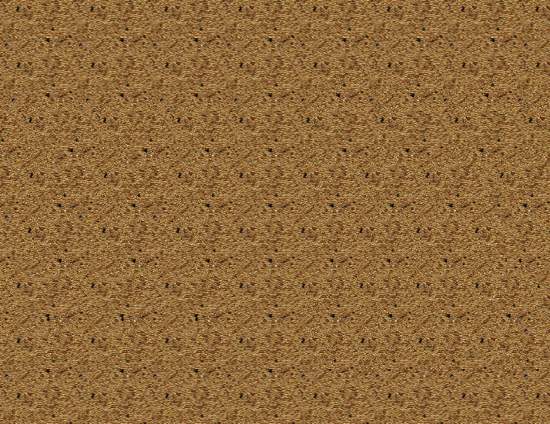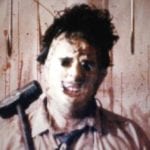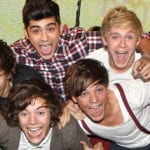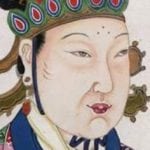 Technology
Technology  Technology
Technology  Humans
Humans 10 Everyday Human Behaviors That Are Actually Survival Instincts
 Animals
Animals 10 Animals That Humiliated and Harmed Historical Leaders
 History
History 10 Most Influential Protests in Modern History
 Creepy
Creepy 10 More Representations of Death from Myth, Legend, and Folktale
 Technology
Technology 10 Scientific Breakthroughs of 2025 That’ll Change Everything
 Our World
Our World 10 Ways Icelandic Culture Makes Other Countries Look Boring
 Misconceptions
Misconceptions 10 Common Misconceptions About the Victorian Era
 Mysteries
Mysteries 10 Strange Unexplained Mysteries of 2025
 Miscellaneous
Miscellaneous 10 of History’s Most Bell-Ringing Finishing Moves
 Technology
Technology Top 10 Everyday Tech Buzzwords That Hide a Darker Past
 Humans
Humans 10 Everyday Human Behaviors That Are Actually Survival Instincts
 Animals
Animals 10 Animals That Humiliated and Harmed Historical Leaders
Who's Behind Listverse?

Jamie Frater
Head Editor
Jamie founded Listverse due to an insatiable desire to share fascinating, obscure, and bizarre facts. He has been a guest speaker on numerous national radio and television stations and is a five time published author.
More About Us History
History 10 Most Influential Protests in Modern History
 Creepy
Creepy 10 More Representations of Death from Myth, Legend, and Folktale
 Technology
Technology 10 Scientific Breakthroughs of 2025 That’ll Change Everything
 Our World
Our World 10 Ways Icelandic Culture Makes Other Countries Look Boring
 Misconceptions
Misconceptions 10 Common Misconceptions About the Victorian Era
 Mysteries
Mysteries 10 Strange Unexplained Mysteries of 2025
 Miscellaneous
Miscellaneous 10 of History’s Most Bell-Ringing Finishing Moves
10 Interesting Facts Behind Popular Posters
Posters have been around for hundreds of years. They have been used for many purposes including promoting products, events patriotism and movie stars. More recently they have become a popular art form, remembering posters of the past and historic photographs. This is a collection of 10 images commonly seen in a poster format, along with what I hope will be some interesting behind the scene information.

I have always suspected that this was a fake or manipulated photo, but it’s the real thing. The legendary photograph was taken by daredevil photographer Charles Ebbets, on September 29, 1932. The photo shows 11 workers having a lunch break on the 69th floor of the RCA Building (now the GE Building) in New York, during the last months of construction. Most of the men have now been identified by family members. The men at the extreme left and extreme right are Matty O’Shaughnessy and Patrick (Sonny) Glynn, both from County Galway, Ireland. The two emigrants had left Shaneaglish in Galway in the 1920s destined for a new life in America. The man sitting fourth from the right is Francis Michael Rafferty and to his right is his lifelong best friend Stretch Donahue. On the same day Ebbets took another photo of the same workers called Men Asleep on a Girder, which shows the same workers napping on the beam. You can see it here.
Interesting Fact: The photo credit on posters was listed as ‘Unknown’ for many years. The copyright owner of the photograph did not recognize Charles C. Ebbets as the photographer until 2003, after months of investigation by a private investigation firm. The photo has also been frequently miss-attributed to Lewis Hine whose photographs documented the construction of the Empire State Building, in 1931.
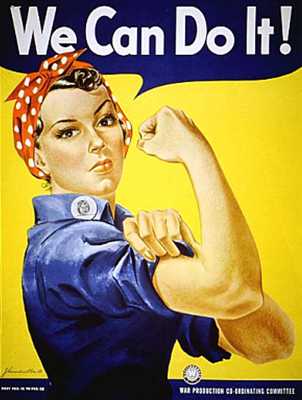
This poster was created by American graphic artist. J. Howard Miller. In 1941, Miller’s work came to the attention of the Westinghouse Company and he was hired to create a series of posters to sponsor the company’s War Production Coordinating Committee. This poster is commonly called Rosie the Riveter, however at the time of the poster’s release that name wasn’t associated with the picture. That came a year later later when a popular patriotic song called “Rosie the Riveter came out. The poster became a symbol for women who produced war supplies and took new jobs replacing the male workers who were in the military. Miller based the “We Can Do It!” poster on a United Press International picture taken of Geraldine Doyle working at a factory. Ironically, Doyle only lasted two weeks on the job before quitting because she feared a hand injury would prevent her from playing her cello. The poster did not become widely known until the 1970s and 80s when it began to be used by advocates of women’s equality in the workplace
Interesting Fact: Geraldine Doyle, who was the inspiration behind the now famous poster, died last year at the age 86. Doyle didn’t know she was the model for the poster until 1984, when she came across an article in Modern Maturity magazine, now known as AARP, which linked a photo of her to the poster. You can see the photo here.
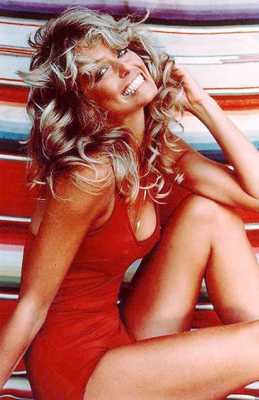
When this photo was taken, Fawcett was still an unknown actress. She had not yet signed on for the hit show Charlie’s Angels, but got some work doing commercials. Her agents wanted a bikini shot of Fawcett and hired freelance photographer Bruce McBroom, who had worked with her before. The shot was taken by a pool at Fawcett’s Bel Air, California, home where she and her husband at the time, actor Lee Majors lived. According to a friend, Fawcett styled her own hair and did her make-up without the aid of a mirror. She heightened her blonde highlights with lemon juice. McBroom used an old Indian Blanket covering his car seat as a backdrop. She tried on several swimsuits, but when Fawcett finally tried on a red one-piece to cover a childhood scar on her stomach, McBroom knew he had something special. Fawcett selected her six favorite pictures out of 40 rolls of film eventually narrowing her choice to the now famous picture. The 1976 poster of Farrah Fawcett sold a Record-breaking 12 million copies.
Interesting Fact: This year on February 2nd, which would have been Farrah Fawcett’s 64th birthday, the family donated several items to the Smithsonian’s National Museum of American History, including the infamous red bathing suit she wore in the famous pin up poster.
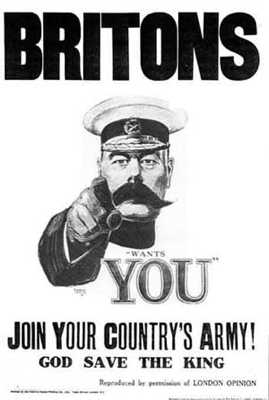
This famous recruitment poster depicting Secretary of State for War, Lord Kitchener, first appeared on September 5th, 1914, on the cover of the London Opinion. During that month the country had its highest number of volunteers. The Parliamentary Recruiting Committee later obtained permission to use the design in a poster format. Kitchener organized the largest volunteer army that the UK had ever seen to fight Germany on the Western Front. In 1916, Lord Kitchener died when the warship taking him to negotiations in Russia was sunk by a German mine. After his death, Kitchener was often dismissed as a great poster but not a great administrator. However, after new records were opened, many historians now praise his strategic vision, especially for laying the groundwork for the expansion of munitions production and his central role in expanding the British army.
Interesting Fact: The poster became the inspiration for the legendary Uncle Sam “I Want You For The US Army” poster, which America used in both World War I and II. It also inspired the famous Smokey the Bear “Only YOU Can Prevent Forest Fires” Poster.
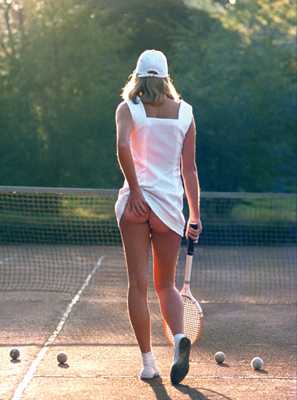
This famous poster is simply called Tennis Girl, and was taken by Martin Elliot, in 1976. When the poster first went on sale it sold more than two million copies. Most likely most were bought by young teenage boys. The photo shows 18 year-old art student Fiona Butler, who was Elliot’s girlfriend at the time, at the Birmingham University courts at Edgbaston. Fiona did not play tennis regularly, and had to borrow the dress and racket from a friend. She wore her father’s plimsolls (early training shoes), and used her dog’s tennis balls to scatter around the court. Elliot then persuaded her to let him take a shot of her hitching up her dress to reveal her bare bottom. Elliott sold the image rights to the poster company Athena, but retained the copyright and earned an estimated £250,000 in royalty payments. Fiona Butler did not receive any money from the poster.
Interesting Fact: This year, after more than 30 years and numerous refusals to pose again, Fiona decided to come forward to promote an exhibition on lawn tennis as a subject in art, which will be held at Birmingham’s Barber Institute of Fine Arts this summer. She believes her picture has earned a place in the history of tennis. Fiona is now a 52 year old mother of three, and is married to a wealthy business man. She has no regrets about posing for the photo, even though she has never earned a penny from it. Photographer Martin Elliot died last year at the age of 63. You can see what Fiona looks like today as she stands next to her famous poster here.
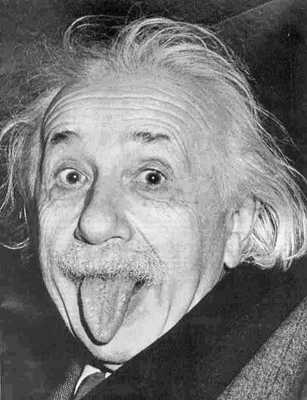
This famous photo and popular poster of Albert Einstein was taken March 14, 1951, by UPI photographer Arthur Sasse. After an event at Princeton to honor Einstein on his 72nd birthday, Sasse and other photographers were desperately trying to convince Einstein to smile for the camera. Einstein was in a car returning from the event and was tired of smiling all day. When the photographers didn’t let him alone he is said to have shouted: “That’s enough, that’s enough!” When these words didn’t deter the photographers, the reaction they received was even better. The photo became one of the most popular photos ever taken of Einstein.
Interesting Fact: Einstein liked the picture so much that he cropped it so only his face could be seen. Then he made several copies of it and sent the picture in greeting cards to friends. The original picture shows Einstein sitting in the backseat of a car between Dr Frank Aydelotte, the former head of the Institute for Advanced Study, and his wife. You can see the original photo here.
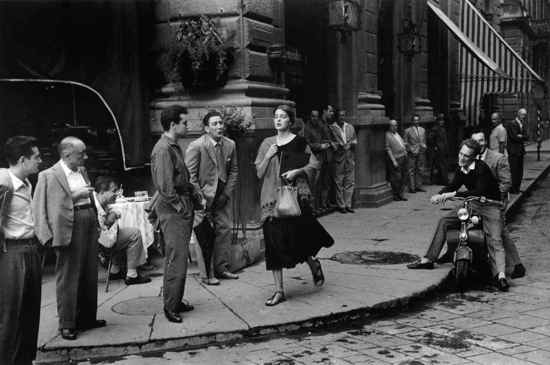
Many will recognize this poster from seeing it in pizza joints around the world. It was taken by American photographer Ruth Orkin, in 1951. Orkin went to Israel on a photo assignment for Life Magazine and from there went to Florence Italy and met artist and fellow American Jinx Allen (now known as Ninalee Craig). The two talked about their shared experiences traveling alone as young single women. Orkin then thought it would be interesting to take pictures of what it’s really like. She titled the series of photographs “Don’t Be Afraid to Travel Alone” Orkin photographed Allan shopping in the markets, crossing traffic, riding a carriage and flirting at a cafe. After Orkin saw Allan walking in the city square and being ogled by men, she asked her to walk through again. She took just two pictures resulting in the now famous photo. Ruth Orkin died of cancer in 1985, at the age of 63.
Interesting Fact: The woman in the photo, Ninalee Craig, is reported as saying “I clutched my shawl to me because that sheaths the body; it was my protection, my shield. I was walking through a sea of men.” Today Craig admits, “I was enjoying every minute of it. They were Italian and I love Italians.” This year marks the 60th anniversary of the photograph. You can see Ninalee Craig standing in front of her poster here.
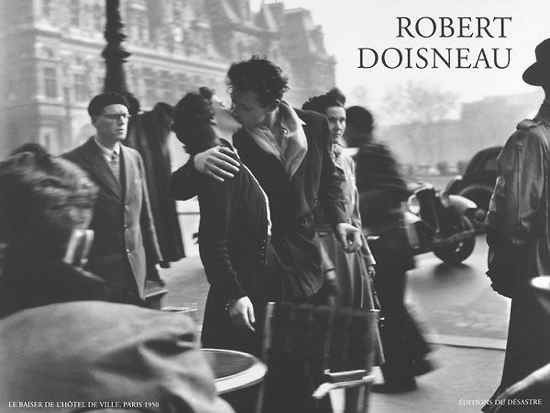
In 1950, Life Magazine asked French photographer Robert Doisneau to do a photo spread about Paris lovers. After spotting a couple kissing, he approached them and asked them if they wouldn’t mind kissing again for the camera. Françoise Delbart, 20, and Jacques Carteaud, 23, were both aspiring actors and were taken to three different places. First Doisneau took some pictures on the Place de la Concorde, then on the Rue de Rivoli, and finally the Hôtel de Ville. After the picture appeared in Life magazine it was forgotten for more than 30 years, and stayed in the archives of the photo agency where Doisneau worked. It was eventually snapped up by a poster company and became one of the world’s best selling posters. Because of the posters success, many people made false claims as to being the kissing couple. In 1993, a couple took Doisneau to court demanding compensation for taking the picture without their knowledge. The lawsuit forced Doisneau to admit that the shot wasn’t spontaneous, and he had used models for the picture. With this admission, the lawsuit was dismissed. After more than 40 years in obscurity, Françoise Delbart, (now Mrs Bornet) came forward with the original print, which bears the photographer’s authentic signature and stamp that Doisneau sent her just a few days after the shoot.
Interesting Fact: Less than a year after the picture was taken, the couple broke up. Francoise married Alain Bornet, a documentary and promotional filmmaker. Jacques Carteaud became a winegrower in the South of France until his death, in 2004. Robert Doisneau continued as a freelance photographer, until he died in 1994, two weeks shy of his 82nd birthday. In 2005, Françoise Bornet put the original print up for auction. She expected to receive about $25,000 for it. The winning bid was 155,000 Euros. (More than $200,000) You can see her in 2005 holding up the famous image here.
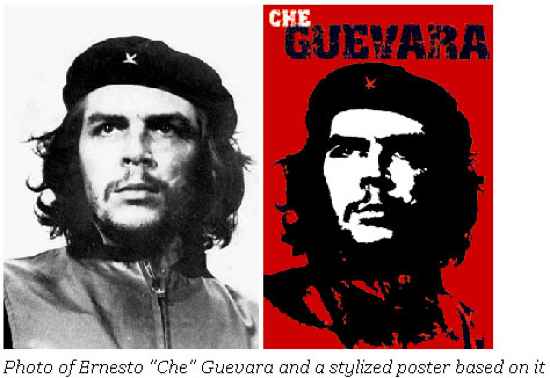
This famous photo, known as Guerrillero Heroico (Heroic Guerrilla) was taken in Havana, Cuba, on March 5, 1960, by Alberto Korda. He snapped the photo when Guevara unexpectedly appeared on the stage for a brief moment, while Fidel Castro was eulogizing the victims of the La Coubre explosion. The two-tone portrait of Che Guevara was created in 1968, by Irish artist Jim Fitzpatrick. The image is rated among the world’s top 10 most iconic images, right alongside the Mona Lisa. It has been reproduced throughout the world on posters, T-shirts and on any surface capable of holding an image. You can see the other photos Korda took on that day here.
Interesting Fact: Because of what he called “crass commercial” utilization of the image, Fitzpatrick announced this year that he intended to copyright the image. He initially released it copyright-free for intended use among revolutionary groups in Europe. He plans to hand over the copyright to the Guevara family.
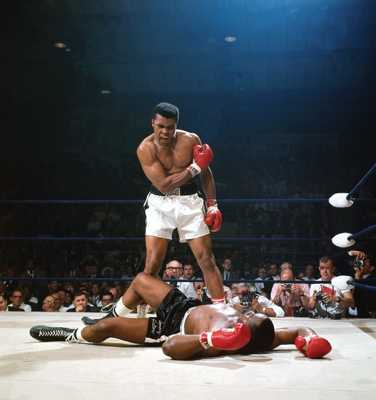
This photograph and popular poster was taken by Sports Illustrated photographer Neil Leifer, who is considered one of the world’s best sports photographers. This particular photo has an extra interesting fact about it so I put it at the number one spot. On May 25, 1965, in Lewiston, Maine, Muhammad Ali and Sonny Liston faced off for the second time. Ali (then Cassius Clay) won the first fight the previous year. The ending of the second fight remains one of the most controversial in boxing history. Half way through the first round, Liston fell to the canvas, which many believe was not a legitimate knockdown. Ali then refused to go to a neutral corner. Instead, Ali stood over Liston, gesturing and yelling at him, “Get up and fight, sucker!” It was then when Liefer snapped the now iconic photo.
Interesting Fact: Liefer said he was lucky to get the shot because he was in the right place. Sports Illustrated often sent out two photographers to cover boxing matches. For this match they assigned Leifer and Herb Scharfman, who was also one of the best. Leifer said this about Scharfman in an interview; “It didn’t make a difference how good he was, he was obviously in the wrong seat.” Herb Scharfman is the photographer that can be seen between Ali’s legs in the famous photo. From 1963 to 1972, Scharfman’s photos appeared on the cover of Sports Illustrated fourteen times. May 25, 1965, just wasn’t his night.
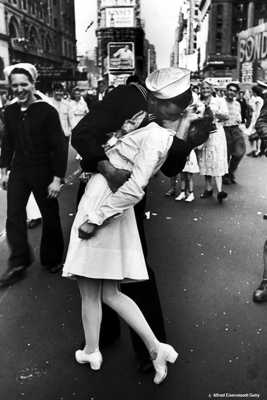
This photograph was taken on August 14, 1945, by Alfred Eisenstaedt, and published a week later in Life magazine. The photo was a spontaneous event (not posed) that occurred in Times Square when it was announced that the war on Japan had ended. Eisenstaedt was taking pictures rapidly at different events during the celebrations, and did not have an opportunity to get the names of the two individuals. Because the faces of both people involved are covered, several people have claimed to be the subjects. The identity of the nurse in the photograph was not known until the late 1970s, when Edith Shain wrote a letter to Eisenstaedt to say that she was the woman in the picture. In the 40s she didn’t think it was dignified to be photographed kissing, but she said times have changed. Of all the nurses claiming to be the one, Eisenstaedt has only backed Shain. Edith Shain who died last year at the age of 91, recalled the moment and said that a sailor grabbed her in an embrace and kissed her, and she thought she might as well let him kiss her since he fought for her in the war. Several men still claim to be the sailor in the photo. The one who stands out the most is Glenn McDuffie, who was 18 when the photo was taken. When he described the kiss on Good Morning America, he said, “It was a good kiss. It was a wet kiss… Someone asked me if it was a tongue kiss. I said, ‘No tongue, but it was a nice kiss.’” McDuffie has passed five polygraph tests confirming his claim.
Interesting Fact: Most are unaware that another photo was taken of the same couple at about the same time at a different angle, by Navy photo journalist Victor Jorgensen. It is also a popular poster. It was published in the New York Times the following day and titled “Kissing the War Goodbye”
You can see the photo here.
These posters became popular in the 90s. In 1991, a computer programmer collaborated with an artist and developed the first sophisticated, full-color stereogram using state of the art 3D modeling software and colorful art techniques. To see the 3D image above allow your eyes to diverge, as if you’re focused on an object more distant than the image itself. “Good Luck”. Click the image to see the original.
